Hard, small, red or white bumps on bottom of feet can be very discomforting. Majority of the reported cases show that the bumps are caused by a treatable benign condition known as athlete’s foot. In this article, we shall explore the possible causes of itchy and painful sore on bottom of feet. We shall also tell you about the pharmacologic and non-pharmacologic measures to get rid of the bumps.
Feet bumps also called nodules, lump, tumor, cyst or contusion are localized swelling or benign growth that appear at the bottom of the feet. The bumps can be caused by a number of thing including inflammation, infection or trauma. Depending on the cause and severity of the lumps, they may be painful or not. An example of a condition that could cause these bumps is athlete’s feet.
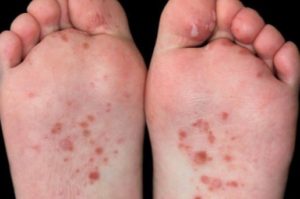
Athlete’s feet is common in adolescent and adults. The condition is common in moist rather than dry feet. According to Timothy Berger in “Current Medical Diagnosis and Treatment” other symptoms that will accompany the bumps will include the formation of scaly, itchy skin on feet mainly in the areas between the toes.
Small Bumps on Bottom of Feet Filled With Fluid
Small bumps or lumps filled with fluid on the bottom of feet can be caused by a rare and inherited condition known as Epidermolysis bullosa (EB). The condition is genetically predisposed. It is a skin disorder that causes the skin to become fragile. With these condition, any trauma or friction will cause the development of very painful fluid-filled blisters.
The small bumps-blisters also referred to as vesicles can also be caused by a number of skin infection including the following:
- Contac dermatitis from poison ivy
- Cold sores in children and adults
- Atopic dermatitis or eczema
- Reaction from skin irritation
- Auto immune diseases such as bullous pemphigoid
- Shingles or chicken pox
- Skin condition known to cause blistering.
Since the cause of the bumps will differ, it is important to first diagnose the condition before you commence treatment. Talk to your dermatology about the best treatment option. Otherwise, topical ointment may be used to soothe skin the skin at home. Antihistamine oral pills or injection may work for allergy related cases.
Clear Bumps on Bottom of Feet
The possible cause of clear bumps on bottom of feet is dyshidrotic eczema or simply dyshidrosis. This is a skin condition where fluid-filled bumps or blister develop on the soles of feet and palm of hands. The blisters are itchy and last for about 2-3 weeks. For most people the condition relates to seasonal allergies or stress.
The exact cause of dyshidrotic eczema is not known. However dermatologist and other skin experts believe the condition to be related to seasoned allergies. Season allergies will include hay fever. At the pick of the allergy, blisters, which are clear fluid-filled bumps will erupt more frequently.
Those with high stress level are also believed to stand high chances of developing the condition. This is for both physical and emotional stress. Doctors believe the condition to be an allergic reaction. It thus possible for those with allergies to have the condition.
According to available statistics, eczema cases are more common in children and infant than in adults. Those with dyshidrotic eczema will have the following symptoms:
- Blisters forming on fingers, toes, hand or bottom of feet
- Clear fluid-filled bumps
- The bumps and blisters will appear on the edges of feet or palm of hand
- Painful small or large blisters
- Itchy and flaky feet
- The bottom of feet becomes Cracked and painful to touch
Depending on the severity of outbreak, you dermatologist will have an array of option for treatment. For the condition, it is encouraged to try more than one treatment option. The option will include the following:
- Corticosteroid creams and ointment that can be applied directly on the affected area. Corticosteroid injection will be prescribed for a more severe outbreak.
- Draining large blisters
- Antihistamines pills and injection
- Topical anti-itching ointments
Bumps on Bottom of Feet that Hurt or Painful
As stated, bumps on bottom of feet can be caused by a number of condition. Traumas and injuries can also cause the damage of the skin causing these bumps. The severity of the pain and itching will depend on what the underlying cause of the bumps is on the first place.
A condition like dyshidrotic eczema is known to cause blistering of the feet and the palm of hand. The presence of the blister on feet sole can hurt and cause a lot of pain, itching and irritation. The treatment option available for the bumps that hurt will depend on what is causing the bums or how severe the pain is.
For mild case, the pain can be relieved at home. Use a cold, wet compress to reduce the discomfort associated with itchy skin. Aloe Vera gel, a well-known anti-itching cream can also help relieve the itching. To reduce the dryness, you can apply a skin moisturizer, petroleum jelly like Vaseline can help do the trick.
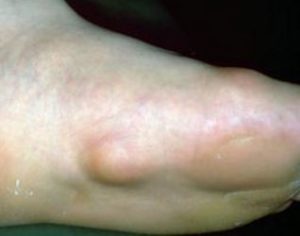
If the pain becomes severe, you need to seek medical attention. Your doctor may prescribe antihistamine or corticosteroids which will help with the inflammation and itching. For large painful bumps, draining the lump may also help get rid of them.
Hard Bumps on Bottom of Feet
As started early, bumps on bottom of feet can be caused by an infection, inflammation or trauma. The general characteristics of the bump will depend on the underlying cause. Some will be hard, small, red white or fluid filled. Below are some of the known causes of hard lumps on feet.
1. Athletes foot
Athlete’s foot medically known as tinea pedis is a common skin infection on the feet. It is a fungal infection affecting the skin between the toes. The infection is contagious and can spread to the toenail or hand. For most people, the infection occurs when you go barefooted in public places such as locker rooms.
Athletes foots is not serious but it is a t time hard to cure. For those with diabetes or weak immune system, you need to seek immediate medical attention if you notice you are infected with the fungus. This can be through direct contact with an infected person or from an infected surface. The fungus will thrive in warm, moist environments. That is why it is common in shower, on locker rooms and around swimming pools.
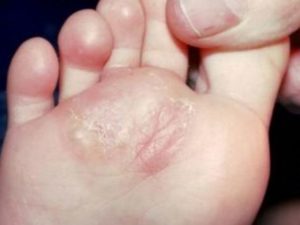
For diagnosis, the common symptoms of these infection will include the following:
- Itching and burning sensation between toe or around feet
- Itchy blisters on the soles of feet
- The feel will become cracked and start to peel
- Dry skin on the sole of feet
- Itchy bums on bottom of feet
- Toenails become discolored, thick and crumbly
- Row skin on the feet
As said, athlete’s foot does not pose a threat to your general body health. For mild cases, over the counter topical antifungal ointments can be used. If that does not work, then you will need too seek medical attention. Your health care provider is likely to prescribe oral antifungal medication, topical steroid to reduce the painful inflammation or oral antibiotic for bacterial infection that develop due to the raw skin. Can help
Simple home remedies like soaking your feet in salty water or diluted vinegar can help dry up the painful blisters. Tea tree oil is another effective home remedy that has been found to effectively treat athlete’s foot. This is a according to the Australian Journal of Dermatology published in August 2002. The journal reported that, 500 percent solution of tea tree oil effectively treated athlete’s foot in 64 percent of the trial participants.
To prevent the infection, you need to do the following:
- Wash your feet with soap and dry them thoroughly every day.
- Use an antifungal powder before and after wearing shoe
- Refrain from sharing soaks, shoe or towel
- Avoid walking bare footed in public showers, around swimming pools and in public places
- Regularly change your soaks
- It is good to alternate between pairs of shoes.
2. Plantar fibroma
Plantar fibroma is a knot or nodule in the arch of the foot. It is a benign bump that grows on the bottom of the foot and usually appears mostly in old people. It is slow growing measuring less than an inch in size. T common symptom of this infection is a painful mass on the bottom of the foot, roughly in the middle of the arch or instep.
The cause of the bump is not known, but it is believed to have a genetic component. No treatment is required for asymptomatic fibromas, however, for painful fibromas, surgery can be used to off-load the insole or pad.
3. Plantar warts
Plantar warts are hard, grainy growths that appear on the heels or balls of the feet. The bumps are also common on areas that feel a lot of pressure. The condition is caused by human papilloma virus that enters the body through cuts, breaks or weak spots on the bottom of the feet.
For most people, the plantar warts are not serious health concern. They therefore require no treatment. The bumps will however cause a lot of discomfort and pain. If the pain becomes unbearable, you will need to seek medical attention to have the plantar warts removed.
4. Foot blister
Bumps on bottom of feet can also be foot blisters. Blisters are small pockets of fluid filled that forms on the upper layers of the skin. The blisters maybe red, tender and causes pain when n motion. The blisters can also be blood filled or pus filled. Most health care provider recommend against draining or popping these kind of blisters.
Blisters on feet can be caused by the following:
- Friction on feet
- Exostoses which is the formation of new bone on the surface of a bone.
- Burn
- Chemical exposure
- Foot perspiration
- Fungal infection as is the case with athlete’s feet
5. Dyshidrotic eczema
Dyshidrotic eczema is a type of eczema or dermatitis characterized by pruritic vesicular eruption on finger, palm and soles. The condition affects teenagers and adults and may be acute, recurrent or chronic.
The blisters appearing May last for around three weeks and causes intense itching. Once they dry the skin appears scaly. For some people, the blisters may recur before the skin heals completely of the previous blisters.
6. Corn and calluses
Corns and calluses are thick, hardened layer that develops when the skin tries to protect itself against friction and pressure. They most often develops on the feet, hands, toes or fingers.
Simply eliminating the source of friction is enough to make the corns and calluses disappear.
Little Red Bumps on Bottom of Feet That Itch
It is very common for people especially men to have little red bumps that itch. Out feet are subjected to a great deal of stress and are susceptible to attacks by infection causing the itching. The feet are exposed to temperatures extremes from the shoe and the physical stress of bearing the body weight. This stress can cause dryness and irritation. These are the common triggers of itching. For most people, the extremes will also leave the feet vulnerable to a fungal infection.
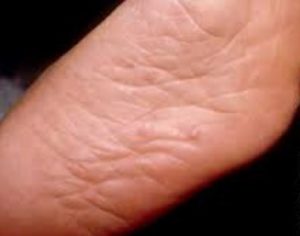
Scratching may help to temporarily relieve the itch, but it will often worsen the condition. It leaves the feet open to a bacterial infection. Below are some of the skin condition that might cause itching.
- Fungal infection
- Contact dermatitis
- Dry skin
- Eczema
Blister Like – Bumps on Bottom of Feet
Blister like bumps on bottom of feet are a common symptoms of dyshidrotic eczema. Also known as dyshidrosis, the condition is known to cause blister that are filled with fluids. The blisters are itchy and lasts for about two to four weeks.
For most people, the bumps are related to seasonal allergies or stress. Dyshidrotic eczema affects teenagers and adults and can be said to acute, recurrent or chronic. For mild cases, corticosteroid creams or ointment maybe applied directly on the infected parts. Pills or injection can help in cases of severe outbreak.
Red Bumps on Bottom of Feet
Red bumps on bottom of feet can be very discomforting and painful. What then do you need to do to get rid of the bumps? To be able to do this, you need to first try to prevent the infection or the condition causing the bumps in first place.
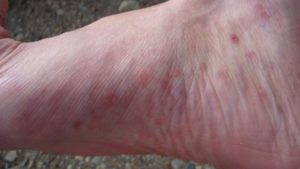
The common cause of the bump is athlete’s foot, a fungal infection that enters the feet through cuts and open. The fungus can be contacted directly from an infected person or from touching contaminated surfaces like public toilets, swimming pools and locker rooms. To prevent this, you need to avoid walking bare footed inn the said places.
Dyshidrotic eczema is another possible cause of red fluid filled bumps on the bottom of feet. The blisters formed are in most cases itchy and last normally for about two to four weeks. For most cases, the condition is related to seasonal allergies.
Knot on Bottom of Feet
Knot on bottom of feet may be caused by a condition known as plantar fibroma. A plantar fibroma is a benign nodule that grows on the bottom of foot. The lumps is slow growing and measures less than an inch in size. The cause of the condition is unknown but it is thought to have a genetic component.
Symptoms include a painful mass on feet roughly in the middle of arch or insteps. The mass will cause a soft convex in the contour of the bottom of the foot that become painful when you wear a shoe.
How to Get Rid of Bumps or Lumps on Bottom of Feet
Bumps on bottom of feet are discomforting. How then do you reduce the discomfort or get rid of the lumps completely? Several pharmacologic and non-pharmacologic measures exist for the treatment.
The treatment of the bumps will depend on what is causing the bumps. Also different treatment will be prescribed depending on the symptoms accompanying the bumps. The symptoms can include itching, pain, swelling and irritation. The following are some options available.
- For large lumps and cyst under feet, your health care provider might prescribe draining out the fluids. A clean syringe is used to squeeze out the content.
- Corticosteroid cream or ointment applied directly on the bumps can also be used.
- In case the bumps become severe, corticosteroid injection may be used.
- Antihistamine medication can also be used if the lumps are caused by allergic reaction.
- For those whose bumps are as a result of auto immune disorder as is the case with skin allergy, immune suppressive maybe used.
How to Get Rid of Lumps on Bottom of Foot – Video
Sources and references
- Cyst, lumps and bumps http://www.webmd.com/skin-problems-and-treatments/guide/cysts-lumps-bumps#1
- Causes of bumps on bottom of feet http://www.newhealthadvisor.com/Bump-on-Bottom-of-Foot.html
- Bumps and lumps on bottom of feet http://www.podiatrynetwork.com/document_disorders.cfm?id=122
- Itchy blisters on bottom of feet https://www.drugs.com/answers/blisters-bottom-foot-itch-hurt-ooze-clear-liquid-717666.html
- Dyshidrotic eczema: http://www.healthline.com/health/dyshidrotic-eczema#Treatment7
- https://www.verywell.com/common-foot-conditions-1337690
